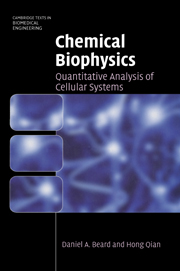Book contents
- Frontmatter
- Contents
- Preface
- Introduction
- Part I Background material
- Part II Analysis and modeling of biochemical systems
- Part III Special topics
- 8 Spatially distributed systems and reaction–diffusion modeling
- 9 Constraint-based analysis of biochemical systems
- 10 Biomacromolecular structure and molecular association
- 11 Stochastic biochemical systems and the chemical master equation
- 12 Appendix: the statistical basis of thermodynamics
- Bibliography
- Index
11 - Stochastic biochemical systems and the chemical master equation
Published online by Cambridge University Press: 05 June 2012
- Frontmatter
- Contents
- Preface
- Introduction
- Part I Background material
- Part II Analysis and modeling of biochemical systems
- Part III Special topics
- 8 Spatially distributed systems and reaction–diffusion modeling
- 9 Constraint-based analysis of biochemical systems
- 10 Biomacromolecular structure and molecular association
- 11 Stochastic biochemical systems and the chemical master equation
- 12 Appendix: the statistical basis of thermodynamics
- Bibliography
- Index
Summary
Overview
Chemical reactions inside cells are ultimately tied to constant thermal motion that brings reacting species into contact and allows reaction systems to cross the free energy barriers that separate distinct chemical states. From the perspective of a molecule, or a collection of molecules, immersed and interacting in a larger system such as a test tube or living cell, thermal agitation contributes an effectively purely random component to the kinetics of the system. The resulting stochastic nature of biochemical systems has received increasing attention in recent years.
While individual molecules behave stochastically in an aqueous solution in test tubes or inside cells, the dynamics of systems consisting of large numbers of molecules is remarkably non-random, deterministic. The emergence of determinism from randomness is a realization of the same law of large numbers that allows Las Vegas casinos to be confident in their profitability. Consider for example tossing three fair coins in the air and observing how many land heads side up. The probability of observing no heads-up outcomes is 1/8 – not astronomically small by any means. The likelihood that 30,000 tosses will result in no heads-up outcomes is 1/230,000, which is a terrifically small number. Though the chance of any one specific outcome (30,000 tails, for example) is vanishingly small, we can predict with great confidence that nearly one half of the total number of tosses will be heads.
- Type
- Chapter
- Information
- Chemical BiophysicsQuantitative Analysis of Cellular Systems, pp. 261 - 281Publisher: Cambridge University PressPrint publication year: 2008



